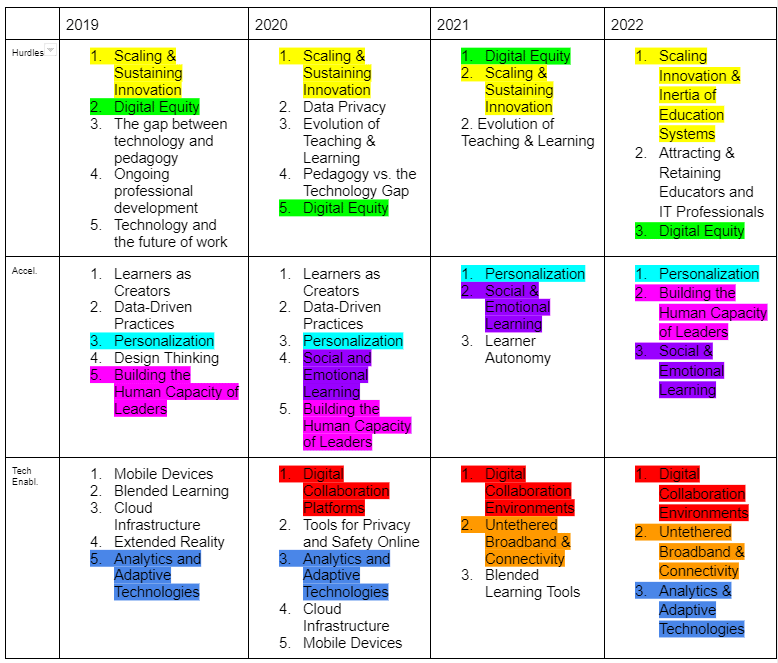Education and technology have changed drastically over the past four years. The global pandemic has caused major disruption in education and devastating learning loss for more than half that time, but it is also reshaping, unleashing a new wave of innovation that will (hopefully) stick around in this new normal. Technology – like virtual reality and artificial intelligence – are entering more classrooms, and the ways in which we teach and learn, including personalized learning and gamification of lessons, have shifted to be more technology focused. But with more technology usage comes greater responsibility to keep students and staff safe online. These are big topics to address, and CoSN’s Driving K-12 Innovation initiative has been there every step of the way.
Since 2019, the project has convened a global Advisory Board of about 100 K-12 educators and IT professionals to share their perspective on the Hurdles, Accelerators, and Tech Enablers that are affecting teaching and learning in schools across the world. Their work is divided into three simple steps – an initial survey, synchronous and asynchronous discussion, and a concluding survey – that gives Ad Board members a plethora of opportunities to have their voices heard.
Below, you’ll see the top Hurdles, Accelerators, and Tech Enablers since the initiative’s inception:
Driving K-12 Innovation Top Topics
2019-2022

And while our Top Topics have shifted throughout the years, we’ve been pleased to have a number of members who’ve participated on the Advisory Board for all four years (and this coming year, as well!). We connected with them to hear what surprised them (and what didn’t) about the chart above.
“Scaling & Sustaining Innovation is not surprising as it is still relevant today. There will be no change in the schooling system without continuous innovation. Otherwise, we will still have 20th-century high stake testing and a content-based curriculum. Scaling & Sustaining Innovation includes many other hurdles, like the gap between technology and pedagogy and evolution of teaching & learning.” Guy Levi (Art of Learning Innovation, Tel Aviv, Israel).
“Digital Equity: this issue mirrors broader society. Whilst inequities and disparities exist in our economies and societies, they will be reflected in the resourcing available to students. As socio-economic gaps widen, this hurdle will remain on the list, and I believe that is critical. Although perpetual, we must keep our eyes on those continuing and everyday hurdles, and continue to strive for change and development and progression towards digital equity. If it were not to feature on our hurdles list, what message would that send to our learning community — surely not that the issue is resolved, and more likely to be that those experiencing the inequities don’t matter.” Karen Swift (James Nash High School, Australia).
“It is interesting to see the consistency in all the topics over the last four years. The consistency is also disturbing. What are the phenomena that drive this consistency? What I am surprised about is that there is not more focus on professional development. Teachers are the cornerstone of overcoming hurdles and leveraging accelerators and enablers. Yet, and I know this is true in my organization, we struggle with how to manage all the learning teachers need.” Vince Humes (Northwest Tri-County Intermediate Unit, Pennsylvania, U.S.).
“The fact that Personalization is present every year reflects that it is a mega trend that is not limited to education and learning. The increased focus on and opportunities for Personalization inevitably leads to challenging communities and social contexts. Thereby, the hurdle of Social and Emotional Learning is related to Personalization.” Claus Gregersen (Herning Gymnasium, Denmark).
“I believe there are significant hurdles that are not technology-oriented in nature but which do stymie the work and sustainability. Some of which are wicked and political problems. The 2022 “Attracting & Retaining…” started to go there. Examples include: sustainable funding & budgeting practices; lack of ambition in Board policy-making around transformation, technology, equity; turnover in Senior Administration and School Boards; distractions from the core mission of Education (Social, Community); and more.” Michael Flood (Kajeet, Maryland, U.S.).
“It is interesting that career-long professional learning morphed into ‘Evolution of Teaching & Learning’ then is bumped by the great resignation. Is this also found in other nations? Is it pay and benefits at the root or the loud micro-minority scorn and derision campaigns? The shortage of professional educators didn’t ever make our lists despite data clearly showing an inadequate number of graduates in the U.S. (not sure about overseas) to fill needs…perhaps a larger equity gap than technologies and bandwidth. Shortages, especially in STEM and skilled vocational trades have been an issue all my life.” Gordon Dahlby (Educational Technology Leadership & Policy Consulting, Iowa, U.S.).
Curious to find out more about CoSN’s Driving K-12 Innovation initiative and read the full reports? Visit the project’s webpage to learn more.
Author: Stephanie King
Published on: November 17, 2022
CoSN is vendor neutral and does not endorse products or services. Any mention of a specific solution is for contextual purposes.


